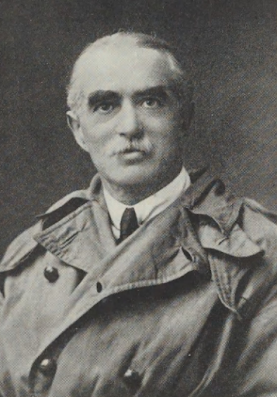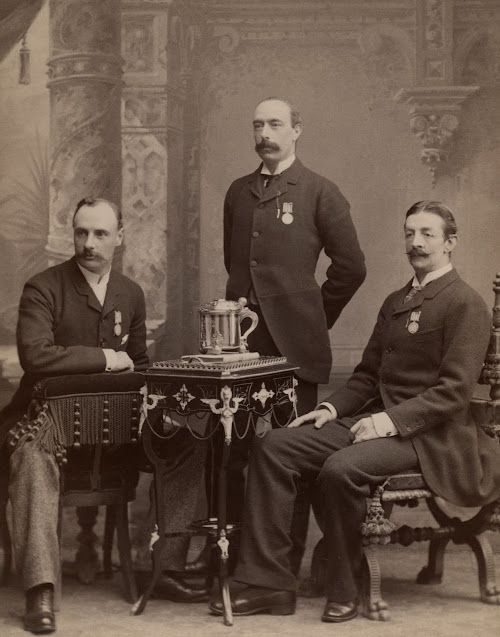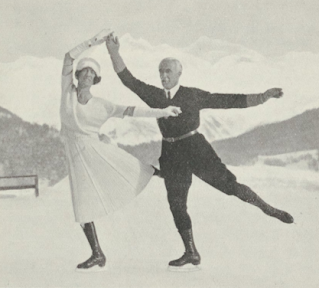"To see Bernard Adams skate [the] rocker was one greatest pleasures. He had neat little feet that fairly twinkled through the turn, while his whole preparation was so gradual yet so complete that although there was plenty of lilt and freedom there seemed to be no effort involved." - Maribel Vinson Owen"
"Bernard Adams, small and beetle-browed, worked with a sort of crusading passion to eradicate the the more glaring faults of his pupils." - J.G. Bergel, "The Citizen", December 28, 1938
Eminent British skating judge, author and historian T.D. Richardson recalled, "Bernard told me that when he was about sixteen years of age his father, architect to the Leeds Corporation, died leaving the family none too well off. He therefore left school, and having nothing to do and looking for a job, was asked if he would care to look after an ice surface which had been laid down in the basement of the Londesborough Theatre in Scarborough. Whether the process, which he told me was the patent of a Serbian Doctor, was that of Professor Gamgee I do not know. He was, furthermore, asked if he would be prepared to demonstrate skating to enquirers. He took on the job, bought a book on skating and taught himself from it." Prior to Bernard's arrival at the Londesborough Theatre rink, a writer using the pseudonym 'Queen Scarborough' described the goings-on there in "London Society" as "bedlam let loose". The inexperienced, self-taught young coach enlisted the help of his brother Alexander and somehow brought order to the chaos.
The Adams brothers were soon invited to teach in London. They brought their widowed mother along for the ride and the trio took up residence at Portland Terrace. The 1901 UK Census listed Bernard's occupation as a "professor of skating".
Bernard and Alexander taught at Prince's Skating Club in Knightsbridge and at the Swiss skating resorts popular during the era in the early twentieth century. They gave similar pairs skating exhibitions in the style later termed 'shadow skating' and were adept at special figures. It was during this period that Bernard became the first person in history to earn the National Skating Association's gold medals in both the English and Continental (International) Styles.
Bernard and Alex Adams with Algernon Grosvenor. Photo courtesy Sveriges Centralförening för Idrottens Främjande Archive.
Bernard and Alexander taught at Prince's Skating Club in Knightsbridge and at the Swiss skating resorts popular during the era in the early twentieth century. They gave similar pairs skating exhibitions in the style later termed 'shadow skating' and were adept at special figures. It was during this period that Bernard became the first person in history to earn the National Skating Association's gold medals in both the English and Continental (International) Styles.
Among Bernard's students were Bror Meyer, a Swede who won the bronze medal at the 1906 World Championships and went to become a famous coach himself, actress and royal mistress Lillie Langtry and of course, T.D. Richardson. Although Bernard taught several excellent figure skaters, he was first and foremost the person that Britain's upper crust went to if they wanted to learn the rudimentary basics of the fine art of skating.
T.D. Richardson recalled, "Bernard was a very fine English stylist who had seen the first introduction of the International style into Britain and who, as a professional teacher, had viewed it with all the knowledge and technique of basic poise, together with the action and counter action of the shoulders and hips requisite for the correct drawings of rockers and counters, brackets and threes. When I, who also started as an English stylist, went to him some years later for lessons in the international style, I well remember him saying: The main difficulty for you, as it was for me, will be to learn to bend your knee; it took me two years and that's about what it will take you: and he was right. Bernard in his day was a fine athlete, smallish but physically very strong." Bernard gave T.D. ('Tyke') the advice, "Go hungry for the ice" meaning you should get on the ice "bursting with desire to skate." T.D. also described him as "possibly the greatest teacher of skating that ever lived" and noted that "he paid great attention to the proper use of the free leg."
After The Great War, Bernard taught at the Manchester Ice Palace and the Palace Hotel Rink in St. Moritz. Two of his more famous pupils during this period were perennial British Champions Ethel Muckelt and Jack Ferguson Page. In the late twenties and early thirties, he taught at the newly opened Westminster Ice Club. Among his pupils were many high society and titled individuals who passed the National Skating Association's tests, including Reginald Maulding - future Chancellor of the Exchequer - and Sir Peter Markham Scott, an Olympic yachtsman and talented glider pilot. In his autobiography "The Eye Of The Wind", Scott described Bernard as "a gentle little man with white hair and moustache and black eyebrows."
Olympic and World Medallist Maribel Vinson came from America to England to work with Bernard in 1934. Maribel described him as her "special mentor". In a piece penned for "Skating" magazine, she recalled, "Although he no longer skates very much himself, his profound knowledge and priceless sense of humour make skating under his watchful eye exacting yet delightful."
Bernard retired in 1935 at the age of sixty-eight. The following year, he became the first professional skater in history to be bestowed a Lifetime Honorary Membership with the National Skating Association.
Ethel Muckelt and Bernard Adams
Bernard retired in 1935 at the age of sixty-eight. The following year, he became the first professional skater in history to be bestowed a Lifetime Honorary Membership with the National Skating Association.
I was fortunate enough to connect with Jane Blake and Emma Kayne, who both provided a wealth of information about Bernard's story, without which this blog would not have been possible. Emma explained, "Bernard was one of those gentlemen of the time who collected stamps, butterflies (of which there are two large museum style cabinets still at my uncle's house), rare eggs etc... I still have lots of old envelopes he collected for the stamps (steamed off), and auction catalogues for stamp auctions. His brother Alexander was my great grandpa, and he married Hilaire Byng, who was a lady in waiting at court to Princess Louise, daughter of Queen Victoria. Hilaire was one of three girls and granddaughter to Viscount Torrington. The marriage caused a scandal as she married out of her class/social status and also to a Catholic, and she was written out of her mother's will, shunned by her sisters and pretty much hounded out of court life. Hilaire and Alexander moved to Appedore where they opened a hotel, but it was not a great success by all accounts. They then retired to Somerset and Bernard joined them in retirement... He never married."
Bernard passed away on July 17, 1941 at the age of seventy-four in England, during the height of The Blitz. He was buried in the church at Swell, in Somerset. The Londesborough Theatre, site of his first coaching job, was demolished in the summer of 1960. Although this legendary "professor of skating" has been largely overlooked, his contributions to the early development of the sport in England and Switzerland were immeasurable.
Skate Guard is a blog dedicated to preserving the rich, colourful and fascinating history of figure skating. Over ten years, the blog has featured over a thousand free articles covering all aspects of the sport's history, as well as four compelling in-depth features. To read the latest articles, follow the blog on Facebook, Twitter, Pinterest and YouTube. If you enjoy Skate Guard, please show your support for this archive by ordering a copy of figure skating reference books "The Almanac of Canadian Figure Skating", "Technical Merit: A History of Figure Skating Jumps" and "A Bibliography of Figure Skating": https://skateguard1.blogspot.com/p/buy-book.html.





